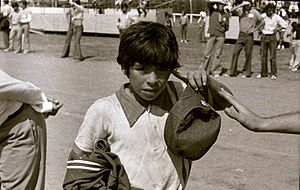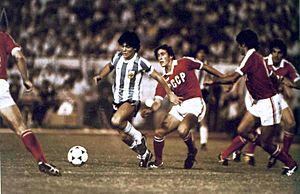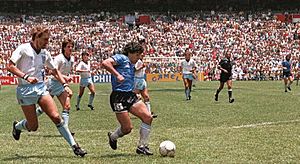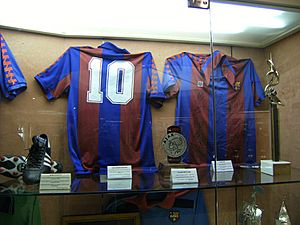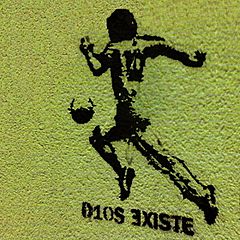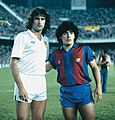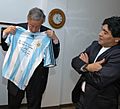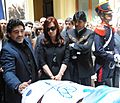Diego Maradona facts for kids
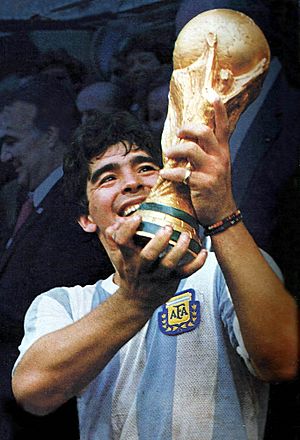
Maradona after winning the 1986 FIFA World Cup with Argentina
|
|||||||||||||||||||||||||||||||||||||||||||
| Personal information | |||||||||||||||||||||||||||||||||||||||||||
|---|---|---|---|---|---|---|---|---|---|---|---|---|---|---|---|---|---|---|---|---|---|---|---|---|---|---|---|---|---|---|---|---|---|---|---|---|---|---|---|---|---|---|---|
| Full name | Diego Armando Maradona | ||||||||||||||||||||||||||||||||||||||||||
| Date of birth | 30 October 1960 | ||||||||||||||||||||||||||||||||||||||||||
| Place of birth | Lanús, Argentina | ||||||||||||||||||||||||||||||||||||||||||
| Date of death | 25 November 2020 (aged 60) | ||||||||||||||||||||||||||||||||||||||||||
| Place of death | Dique Luján, Argentina | ||||||||||||||||||||||||||||||||||||||||||
| Height | 1.65 m | ||||||||||||||||||||||||||||||||||||||||||
| Playing position | Attacking midfielder, second striker | ||||||||||||||||||||||||||||||||||||||||||
| Youth career | |||||||||||||||||||||||||||||||||||||||||||
| 1969–1976 | Argentinos Juniors | ||||||||||||||||||||||||||||||||||||||||||
| Senior career* | |||||||||||||||||||||||||||||||||||||||||||
| Years | Team | Apps† | (Gls)† | ||||||||||||||||||||||||||||||||||||||||
| 1976–1981 | Argentinos Juniors | 166 | (116) | ||||||||||||||||||||||||||||||||||||||||
| 1981–1982 | Boca Juniors | 40 | (28) | ||||||||||||||||||||||||||||||||||||||||
| 1982–1984 | Barcelona | 36 | (22) | ||||||||||||||||||||||||||||||||||||||||
| 1984–1991 | Napoli | 188 | (81) | ||||||||||||||||||||||||||||||||||||||||
| 1992–1993 | Sevilla | 26 | (5) | ||||||||||||||||||||||||||||||||||||||||
| 1993–1994 | Newell's Old Boys | 5 | (0) | ||||||||||||||||||||||||||||||||||||||||
| 1995–1997 | Boca Juniors | 30 | (7) | ||||||||||||||||||||||||||||||||||||||||
| Total | 491 | (259) | |||||||||||||||||||||||||||||||||||||||||
| National team | |||||||||||||||||||||||||||||||||||||||||||
| 1977–1979 | Argentina U20 | 15 | (8) | ||||||||||||||||||||||||||||||||||||||||
| 1977–1994 | Argentina | 91 | (34) | ||||||||||||||||||||||||||||||||||||||||
| Teams managed | |||||||||||||||||||||||||||||||||||||||||||
| 1994 | Deportivo Mandiyú | ||||||||||||||||||||||||||||||||||||||||||
| 1995 | Racing Club | ||||||||||||||||||||||||||||||||||||||||||
| 2008–2010 | Argentina | ||||||||||||||||||||||||||||||||||||||||||
| 2011–2012 | Al-Wasl | ||||||||||||||||||||||||||||||||||||||||||
| 2013–2017 | Deportivo Riestra (assistant) | ||||||||||||||||||||||||||||||||||||||||||
| 2017–2018 | Fujairah | ||||||||||||||||||||||||||||||||||||||||||
| 2018–2019 | Dorados de Sinaloa | ||||||||||||||||||||||||||||||||||||||||||
| 2019–2020 | Gimnasia de La Plata | ||||||||||||||||||||||||||||||||||||||||||
|
Honours
|
|||||||||||||||||||||||||||||||||||||||||||
|
|||||||||||||||||||||||||||||||||||||||||||
Diego Armando Maradona ( 30 October 1960 – 25 November 2020) was an Argentine professional football player and manager. He was widely regarded as one of the greatest players in the history of the sport. Maradona was one of the two joint winners of the FIFA Player of the 20th Century award.
Maradona was given the nickname "El Pibe de Oro" ("The Golden Boy"), a name that stuck with him throughout his career. His number was 10.
Maradona was the first player to set the world record transfer fee twice: in 1982 when he transferred to Barcelona for £5 million, and in 1984 when he moved to Napoli for a fee of £6.9 million. He played for Argentinos Juniors, Boca Juniors, Barcelona, Napoli, Sevilla, and Newell's Old Boys during his club career, and is most famous for his time at Napoli where he won numerous accolades.
In his international career with Argentina, he earned 91 caps and scored 34 goals. Maradona played in four FIFA World Cups, including the 1986 World Cup in Mexico, where he captained Argentina and led them to victory over West Germany in the final, and won the Golden Ball as the tournament's best player.
In the 1986 World Cup quarter final, he scored both goals in a 2–1 victory over England that entered football history for two different reasons. The first goal was an unpenalized handling foul known as the "Hand of God", while the second goal followed a 60 m (66 yd) dribble past five England players, voted "Goal of the Century" by FIFA.com voters in 2002.
Maradona became the coach of Argentina's national football team in November 2008. He was in charge of the team at the 2010 World Cup in South Africa before leaving at the end of the tournament. He then coached Dubai-based club Al Wasl in the UAE Pro-League for the 2011–12 season. In 2017, Maradona became the coach of Fujairah before leaving at the end of the season.
In May 2018, Maradona was announced as the new chairman of Belarusian club Dynamo Brest. He arrived in Brest and was presented by the club to start his duties in July. From September 2018 to June 2019, Maradona was coach of Mexican club Dorados. He was the coach of Argentine Primera División club Gimnasia de La Plata from September 2019 until his death in November 2020.
Contents
Early years
Diego Armando Maradona was born on 30 October 1960, at the Policlínico (Polyclinic) Evita Hospital in Lanús, Buenos Aires Province to a poor family that had moved from Corrientes Province. He was raised in Villa Fiorito, a shantytown on the southern outskirts of Buenos Aires, Argentina. He was the first son after four daughters. He has two younger brothers, Hugo (el Turco) and Raúl (Lalo), both of whom were also professional football players. His father Diego Maradona "Chitoro" (1927–2015), who worked at a chemicals factory, was of Guaraní (Indigenous) and Spanish (Basque) descent, and his mother Dalma Salvadora Franco, "Doña Tota" (1930–2011), was of Italian and Croatian descent.
When Diego came to Argentinos Juniors for trials, I was really struck by his talent and couldn't believe he was only eight years old. In fact, we asked him for his ID card so we could check it, but he told us he didn't have it on him. We were sure he was having us on because, although he had the physique of a child, he played like an adult. When we discovered he'd been telling us the truth, we decided to devote ourselves purely to him.
Maradona received his first football as a gift at age three and quickly became devoted to the game. At age eight, he was spotted by a talent scout while he was playing in his local club Estrella Roja. In March 1969 he was recommended to Los Cebollitas (The Little Onions), the junior team of Buenos Aires's Argentinos Juniors by his close friend and football rival Gregorio Carrizo who had already been picked by coach Francis Gregorio Cornejo.
Maradona became a star for the Cebollitas, and as a 12-year-old ball boy he amused spectators by showing his ball skills during the halftime breaks of Argentinos Juniors' first division games. During 1973 and 1974, Maradona led Cebollitas to two Evita Tournament wins and 141 undefeated games in a row, playing alongside players like Adrian Domenech and Claudio Rodríguez, in what is regarded as the best youth team in the history of Argentine football. Maradona named Brazilian playmaker Rivellino and Manchester United winger George Best among his inspirations growing up.
Club career
Argentina
On 20 October 1976, Maradona made his professional debut for Argentinos Juniors, 10 days before his 16th birthday, versus Talleres de Córdoba. He entered to the pitch wearing the number 16 jersey, and became the youngest player in the history of the Argentine Primera División.
Maradona scored his first goal in the Primera División against Marplatense team San Lorenzo on 14 November 1976, two weeks after turning 16.
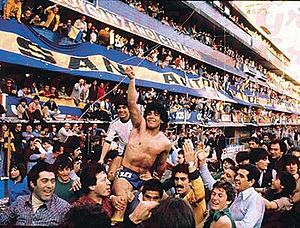
Maradona spent five years at Argentinos Juniors, from 1976 to 1981, scoring 115 goals in 167 appearances before his US$4 million transfer to Boca Juniors. He signed a contract with Boca Juniors on 20 February 1981. He made his debut two days later against Talleres de Córdoba, scoring twice in the club's 4–1 win. Boca had a successful season, winning the league title after securing a point against Racing Club. That would be the only title won by Maradona in the Argentine domestic league.
Barcelona
"He had complete mastery of the ball. When Maradona ran with the ball or dribbled through the defence, he seemed to have the ball tied to his boots. I remember our early training sessions with him: the rest of the team were so amazed that they just stood and watched him. We all thought ourselves privileged to be witnesses of his genius."
After the 1982 World Cup, in June, Maradona was transferred to Barcelona in Spain for a then world record fee of £5 million ($7.6 million). In 1983, under coach César Luis Menotti, Barcelona and Maradona won the Copa del Rey (Spain's annual national cup competition), beating Real Madrid, and the Spanish Super Cup, beating Athletic Bilbao. On 26 June 1983, Barcelona won away to Real Madrid in one of the world's biggest club games, El Clásico, a match where Maradona scored and became the first Barcelona player to be applauded by arch-rival Real Madrid fans.
Napoli
Maradona transferred to Napoli in Italy's Serie A for another world record fee, £6.9 million ($10.48 million). Maradona was presented to the world media as a Napoli player on 5 July 1984, where he was welcomed by 75,000 fans at his presentation at the Stadio San Paolo.
At Napoli, Maradona reached the peak of his professional career: he soon inherited the captain's armband from Napoli veteran defender Giuseppe Bruscolotti and quickly became an adored star among the club's fans. In his time there he elevated the team to the most successful era in its history. Led by Maradona, Napoli won their first ever Serie A Italian Championship in 1986–87.
Napoli would win their second league title in 1989–90, and finish runners up in the league twice, in 1987–88 and 1988–89. Other honours during the Maradona era at Napoli included the Coppa Italia in 1987 (as well as a second-place finish in the Coppa Italia in 1989), the UEFA Cup in 1989, and the Italian Supercup in 1990.
Although Maradona was successful on the field during his time in Italy, his personal problems increased. He faced a scandal there regarding an illegitimate son, and he was also the object of some suspicion over an alleged friendship with the Camorra crime syndicate. He also faced intense backlash and harassment from some local fans after the 1990 World Cup, in which he and Argentina beat Italy in a semi-final match at the San Paolo stadium. In 2000, the number 10 jersey of Napoli was officially retired. On 4 December 2020, nine days after Maradona's death, Napoli's home stadium was renamed Stadio Diego Armando Maradona.
Late career
Maradona left Napoli in 1992. Despite interest from Real Madrid and Marseille, he signed for Sevilla, where he stayed for one year. In 1993, he played for Newell's Old Boys and in 1995 returned to Boca Juniors for a two-year stint. Maradona also appeared for Tottenham Hotspur in a testimonial match for Osvaldo Ardiles against Internazionale, shortly before the 1986 World Cup. In 1996, he played in a friendly match alongside his brother Raul for Toronto Italia against the Canadian National Soccer League All-Stars. In 2000 he captained Bayern Munich in a friendly against the German national team in the farewell game of Lothar Matthäus. Maradona was himself given a testimonial match in November 2001, played between an all-star World XI and the Argentina national team.
International career
During his time with the Argentina national team, Maradona scored 34 goals in 91 appearances. He made his full international debut at age 16, against Hungary, on 27 February 1977. Maradona was left off the Argentine squad for the 1978 World Cup on home soil by coach César Luis Menotti who felt he was too young at age 17. At age 18, Maradona played the 1979 FIFA World Youth Championship in Japan and emerged as the star of the tournament, shining in Argentina's 3–1 final win over the Soviet Union, scoring a total of six goals in six appearances in the tournament. On 2 June 1979, Maradona scored his first senior international goal in a 3–1 win against Scotland at Hampden Park. He went on to play for Argentina in two 1979 Copa América ties during August 1979, a 2–1 loss against Brazil and a 3–0 win over Bolivia in which he scored his side's third goal.
Maradona and his compatriot Lionel Messi are the only players to win the Golden Ball at both the FIFA U-20 World Cup and FIFA World Cup. Maradona did so in 1979 and 1986, which Messi emulated in 2005 and 2014 (and again in 2022).
World Cups
Maradona played his first World Cup tournament in 1982. Maradona captained the Argentine national team to victory in the 1986 World Cup in Mexico, winning the final in Mexico City against West Germany.
He scored two goals in the 2–1 quarter-final win against England. Replays showed that the first goal was scored by striking the ball with his hand. Maradona was coyly evasive, describing it as "a little with the head of Maradona and a little with the hand of God". It became known as the "Hand of God". Ultimately, on 22 August 2005, Maradona acknowledged on his television show that he had hit the ball with his hand purposely, and no contact with his head was made, and that he immediately knew the goal was illegitimate. This became known as an international fiasco in World Cup history. The goal stood, much to the wrath of the English players.
Maradona's second goal, just four minutes after the hotly disputed hand-goal, was later voted by FIFA as the greatest goal in the history of the World Cup. He received the ball in his own half, swivelled around and with 11 touches ran more than half the length of the field, dribbling past five English outfield players (Peter Beardsley, Steve Hodge, Peter Reid, Terry Butcher, and Terry Fenwick) before he left goalkeeper Peter Shilton on his backside with a feint, and slotted the ball into the net. This goal was voted "Goal of the Century" in a 2002 online poll conducted by FIFA. A 2002 Channel 4 poll in the UK saw his performance ranked number 6 in the list of the 100 Greatest Sporting Moments.
During the tournament, Maradona attempted or created more than half of Argentina's shots, attempted a tournament-best 90 dribbles – three times more than any other player – and was fouled a record 53 times, winning his team twice as many free kicks as any player. Maradona scored or assisted 10 of Argentina's 14 goals (71%), including the assist for the winning goal in the final, ensuring that he would be remembered as one of the greatest names in football history. By the end of the World Cup, Maradona went on to win the Golden Ball as the best player of the tournament by unanimous vote and was widely regarded to have won the World Cup virtually single-handedly, something that he later stated he did not entirely agree with. Zinedine Zidane, watching the 1986 World Cup as a 14-year-old, stated Maradona "was on another level". In a tribute to him, Azteca Stadium authorities built a statue of him scoring the "Goal of the Century" and placed it at the entrance of the stadium.

Maradona captained Argentina again in the 1990 World Cup in Italy to yet another World Cup final. At the final in Rome, Argentina lost 1–0 to West Germany, the only goal being a controversial penalty scored by Andreas Brehme in the 85th minute, after Rudi Völler was adjudged to be fouled.
At the 1994 World Cup in the United States, Maradona played in only two games (both at the Foxboro Stadium near Boston), scoring one goal against Greece, before being sent home after failing a doping test.
Retirement and tributes
In 1990, the Konex Foundation from Argentina granted him the Diamond Konex Award, one of the most prestigious culture awards in Argentina, as the most important personality in Sports in the last decade in his country.
In 2000, Maradona published his autobiography Yo Soy El Diego ("I am The Diego"), which became a best-seller in Argentina. Two years later, Maradona donated the Cuban royalties of his book to "the Cuban people and Fidel".
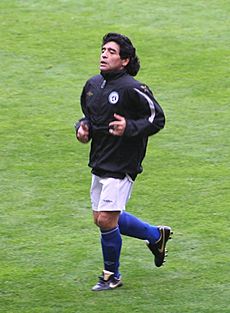
In 2000, he won FIFA Player of the Century award which was to be decided by votes on their official website, their official magazine and a grand jury. Maradona won the Internet-based poll, garnering 53.6% of the votes against 18.53% for Pelé.
Maradona also came fifth in the vote of the IFFHS (International Federation of Football History and Statistics).
In 2001, the Argentine Football Association (AFA) asked FIFA for authorization to retire the jersey number 10 for Maradona. FIFA did not grant the request, even though Argentine officials have maintained that FIFA hinted that it would.
Maradona has topped a number of fan polls, including a 2002 FIFA poll in which his second goal against England was chosen as the best goal ever scored in a World Cup; he also won the most votes in a poll to determine the All-Time Ultimate World Cup Team.
On 22 March 2010, Maradona was chosen number 1 in 'The Greatest 10 World Cup Players of All Time' by the London-based newspaper The Times.
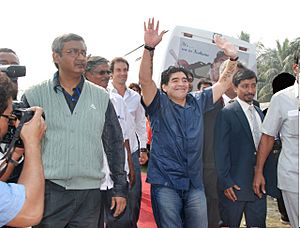
In 2008, Serbian filmmaker Emir Kusturica made Maradona, a documentary about Maradona's life.
Managerial career
Club management
Maradona began his managerial career alongside former Argentinos Juniors midfield teammate Carlos Fren. In May 2011 he became manager of Dubai club Al Wasl FC in the United Arab Emirates and was sacked on 10 July 2012. In August 2013, Maradona moved on to become 'spiritual coach' at Argentine club Deportivo Riestra. In May 2018, Maradona was announced as the new chairman of Belarusian club Dynamo Brest. In September 2018, he was appointed manager of Mexican second division side Dorados. He made his debut with Dorados on 17 September with a 4–1 victory over Cafetaleros de Tapachula. On 13 June 2019, after Dorados failed to clinch promotion to the Mexican top flight, Maradona's lawyer announced that he would be stepping down from the role, citing health reasons. On 5 September 2019, Maradona was unveiled as the new head coach of Gimnasia de La Plata, signing a contract until the end of the season. After two months in charge he left the club on 19 November. However, two days later, Maradona rejoined the club as manager saying that "we finally achieved political unity in the club". In November 2020, Maradona died in post. His coaching staff resigned from the club following his death.
International management
On 29 October 2008, AFA chairman Julio Grondona confirmed that Maradona would be the head coach of the Argentina national team. On 19 November, Maradona managed Argentina for the first time when they played against Scotland at Hampden Park in Glasgow, which Argentina won 1–0.

After winning his first three matches as the coach of the national team, he oversaw a 6–1 defeat to Bolivia. With two matches remaining in the qualification tournament for the 2010 World Cup, Argentina was in fifth place and faced the possibility of failing to qualify, but victory in the last two matches secured qualification for the finals.
After defeating Mexico 3–1, however, Argentina was routed by Germany 4–0 in the quarter-finals to go out of the competition. After the defeat to Germany, Maradona admitted that he was reconsidering his future as Argentina's coach. On 27 July, however, the AFA announced that its board had unanimously decided not to renew his contract.
Personal life
Family
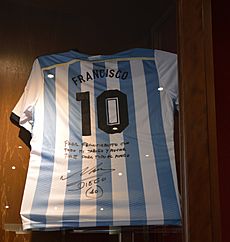
Maradona married long-time fiancée Claudia Villafañe on 7 November 1989 in Buenos Aires, and they had two daughters, Dalma Nerea (born 2 April 1987) and Gianinna Dinorah (born 16 May 1989), by whom he became a grandfather in 2009 after she married Sergio Agüero (now divorced).
Maradona and Villafañe divorced in 2004. Maradona admitted that he was the father of Diego Sinagra (born in Naples on 20 September 1986). Diego Junior met Maradona for the first time in May 2003 after tricking his way onto a golf course in Italy where Maradona was playing. Sinagra is now a footballer playing in Italy.
After the divorce, Claudia embarked on a career as a theatre producer, and Dalma sought an acting career; she previously had expressed her desire to attend the Actors Studio West in Los Angeles.
Maradona's great-nephew Hernán López is also a professional footballer.
Death
On 2 November 2020, Maradona was admitted to a hospital in La Plata, supposedly for psychological reasons. A representative of the ex-footballer said his condition was not serious. A day later, he underwent emergency brain surgery to treat a subdural hematoma.
He was released on 12 November after successful surgery and was supervised by doctors as an outpatient. On 25 November, at the age of 60, Maradona suffered cardiac arrest and died in his sleep at his home in Dique Luján, Buenos Aires Province, Argentina. Maradona was buried next to his parents at the Jardín de Bella Vista cemetery in Bella Vista, Buenos Aires.
In popular culture
In Argentina, Maradona is considered an icon and is often talked about in terms reserved for legends.
Maradona was included in many cameos in the Argentine comic book El Cazador de Aventuras. After the closing of it, the authors started a new short-lived comic book titled El Die, using Maradona as the main character.
Maradona has had several online Flash games that are entirely dedicated to his legacy. In Rosario, Argentina, locals organized the parody religion of the "Church of Maradona". The organization reformulates many elements from Christian tradition, such as Christmas or prayers, reflecting instead details from Maradona. It had 200 founding members, and tens of thousands more have become members via the church's official web site.
Many Argentine artists performed songs in tribute to Diego, such as "La Mano de Dios" by El Potro Rodrigo, "Maradona" by Andrés Calamaro, "Para siempre Diego" (Diego Forever) by Los Ratones Paranoicos, "Francotirador" (Sniper) by Attaque 77, "Maradona Blues" by Charly García, "Santa Maradona" (Saint Maradona) by Mano Negra, and "La Vida Tómbola" by Manu Chao, among others. There are also other films, such as: Maradona, La Mano de Dios (Maradona, the Hand of God), Amando a Maradona (Loving Maradona), and Maradona by Kusturica. In March 1981, Queen were introduced to Maradona backstage during their concert at the Vélez Sarsfield Stadium.
By 1982, Maradona had become one of the biggest sports stars in the world and had endorsements with many companies, including Puma and Coca-Cola, earning him an additional $1.5 million per year on top of his club salary. In 1982, he featured in a World Cup commercial for Coca-Cola, and a Japanese commercial for Puma. In 1984 he earned $7m a year at Napoli, and sponsorships included $5m from Hitachi. In 1984, a poll from IMG named Maradona the best known person in the world. In 2010 he appeared in a commercial for French fashion house Louis Vuitton, indulging in a game of table football with fellow World Cup winners Pelé and Zinedine Zidane. Maradona featured in the music video to the 2010 World Cup song "Waka Waka" by Shakira, with footage shown of him celebrating Argentina winning the 1986 World Cup.
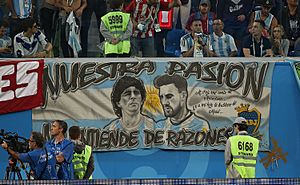
A 2006 television commercial for Brazilian soft drink Guaraná Antarctica portrayed Maradona as a member of the Brazil national team, including wearing the yellow jersey and singing the Brazilian national anthem with Brazilian players Ronaldo and Kaká. Later on in the commercial he wakes up realizing it was a nightmare after having too much of the drink. This generated some controversy in the Argentine media after its release (although the commercial was not supposed to air for the Argentine market, fans could see it online). Maradona replied that he had no problem wearing the Brazilian national squad jersey despite Argentina and Brazil's tense football rivalry, but that he would refuse to wear the shirt of River Plate, Boca Juniors' traditional rival. There is a documented phenomenon of Brazilians being named in honour of Maradona, an example being footballer Diego Costa.
In 2017, Maradona featured as a legendary player in the football video games FIFA 18 and Pro Evolution Soccer 2018. In 2019, a documentary film titled Diego Maradona was released by Academy Award and BAFTA Award winning filmmaker Asif Kapadia, director of Amy (on singer Amy Winehouse) and Senna (on motor racing driver Ayrton Senna). Kapadia stated that " ...Maradona is the third part of a trilogy about child geniuses and fame." He added, "...I was fascinated by his journey, wherever he went there were moments of incredible brilliance and drama. He was a leader, taking his teams to the very top, but also many lows in his career. He was always the little guy fighting against the system... and he was willing to do anything, to use all of his cunning and intelligence to win."
Images for kids
-
The moment when Atlético de Bilbao defender Andoni Goikoetxea injured Maradona on 24 September 1983
-
Maradona with his fellow countryman Mario Kempes before a Barcelona match against Valencia
-
Maradona saluting the crowd at the Stadio San Paolo in Naples during his presentation on 5 July 1984
-
Maradona at the Foxboro Stadium in Massachusetts, going to do a drug test after playing v Nigeria, 25 June 1994
-
Maradona at the 2018 FIFA World Cup in Russia, where he was treated by paramedics after collapsing following Argentina's victory over Nigeria.
-
Maradona (right) presenting a signed jersey to the former President of Argentina Néstor Kirchner in December 2007
-
Maradona, then-president Cristina Fernández de Kirchner and Evo Morales, at the funeral of former President of Argentina Néstor Kirchner, 28 October 2010
-
Maradona (center) visiting Argentina's new president Alberto Fernández (right) in December 2019
-
Maradona (middle) with Queen during the rock band's 1981 South American tour
-
Maradona's Golden Foot award in "The Champions Promenade" on the seafront of the Principality of Monaco
See also
 In Spanish: Diego Maradona para niños
In Spanish: Diego Maradona para niños


